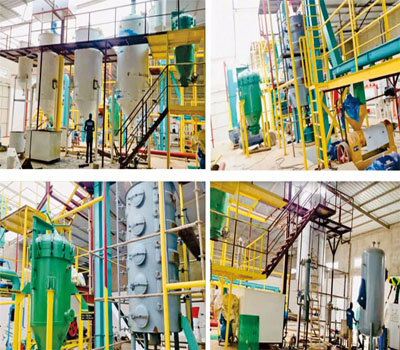Deacidification methods commonly used in edible oil refining equipment
Edible oil is an essential cooking material in our daily life, and refining is an important link in the production process of edible oil, in which deacidification is a key step. The purpose of deacidification is to remove free fatty acids from oil, improve the quality of oil, and improve its stability and storage performance. At present, the deacidification methods commonly used in edible oil refining equipment mainly include physical deacidification, alkali refining neutralization method deacidification.

Physical deacidification
Physical deacidification is a method to remove free fatty acids by high temperature steam distillation. This method uses the characteristic that fatty acids are easy to volatilize under high temperature and vacuum conditions to separate them from oil. Physical deacidification has the following advantages:
- Good refining effect: It can effectively remove free fatty acids from oil and other impurities.
- Preserve nutrients: Physical deacidification can preserve natural nutrients in oil to a certain extent, such as vitamin E and phytosterol, because no chemical reagents are added.
- Strong environmental protection: No chemical waste liquid will be generated during physical deacidification, which is environmentally friendly. However, physical deacidification also has some shortcomings, such as high equipment investment, high requirements for operation technology and high energy consumption.
Deacidification by neutralization method in alkali refining
Alkaline Deacidification by neutralization method in alkali refining
Alkaline is the neutralization reaction between alkaline solution (such as sodium hydroxide) and free fatty acids in oils and fats to generate soapstock, and then the soapstock and oils are separated by separation. This method is a traditional deacidification process and has the following characteristics:
- Lower cost: Compared with physical deacidification, the initial investment of neutralization method in alkali refining is less. However, there are also some problems in the neutralization method of alkali refining, such as the loss of oil to a certain extent, and the generated soap residue needs further treatment, which may cause pollution to the environment. In addition, this method will destroy the nutrients in the oil to some extent.
- Lower cost: Compared with physical deacidification, the initial investment of neutralization method in alkali refining is less. However, there are also some problems in the neutralization method of alkali refining, such as the loss of oil to a certain extent, and the generated soap residue needs further treatment, which may cause pollution to the environment. In addition, this method will destroy the nutrients in the oil to some extent.
Choice of two methods
In actual production, which deacidification method to choose depends on the specific situation. Physical deacidification may be more suitable if the enterprise pursues high-quality oil products and has high equipment investment ability; For some small and medium-sized enterprises, the neutralization method of alkali refining may be more economical.
In short, no matter which method is chosen, the purpose is to produce high-quality, safe and reliable edible oil. With the continuous progress of technology, it is believed that there will be a more efficient and environmentally friendly deacidification process in the future to provide people with healthier edible oil products.
